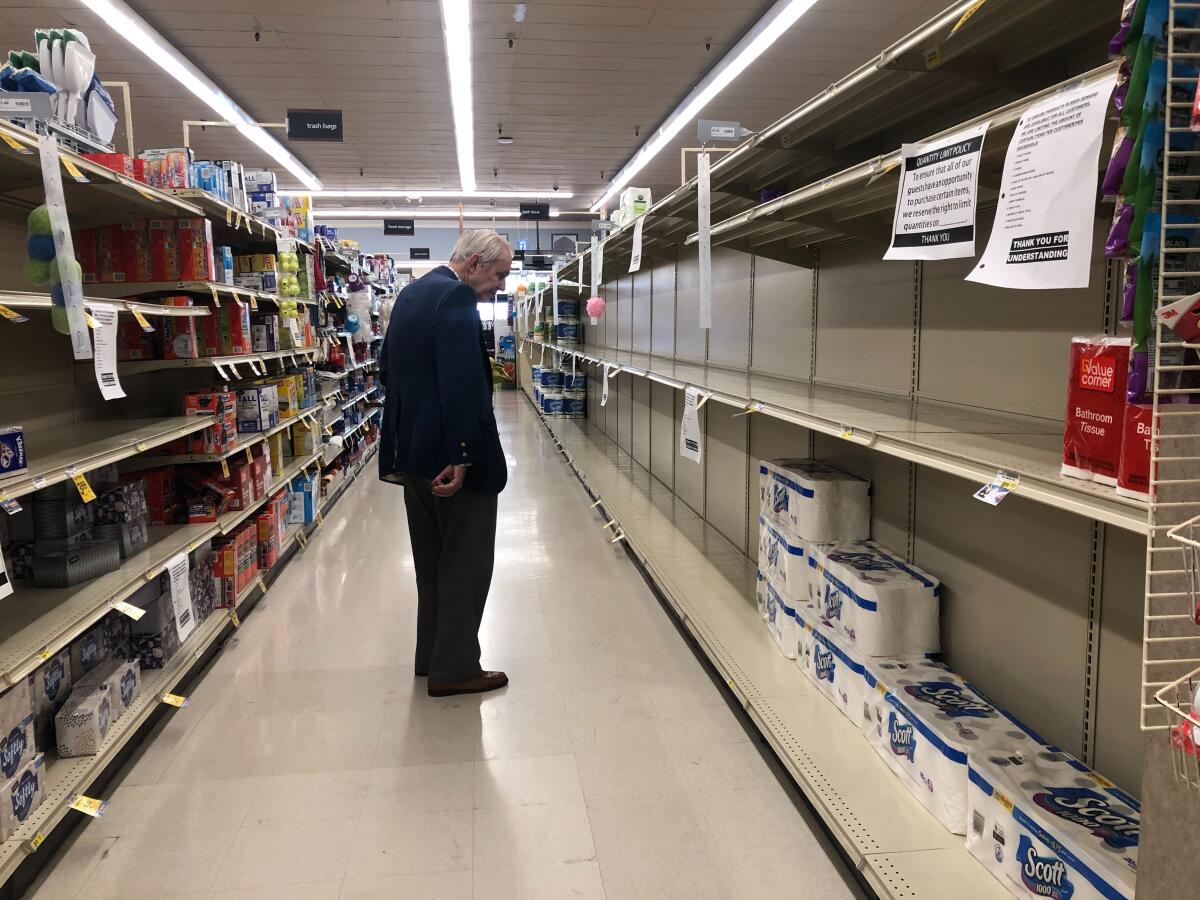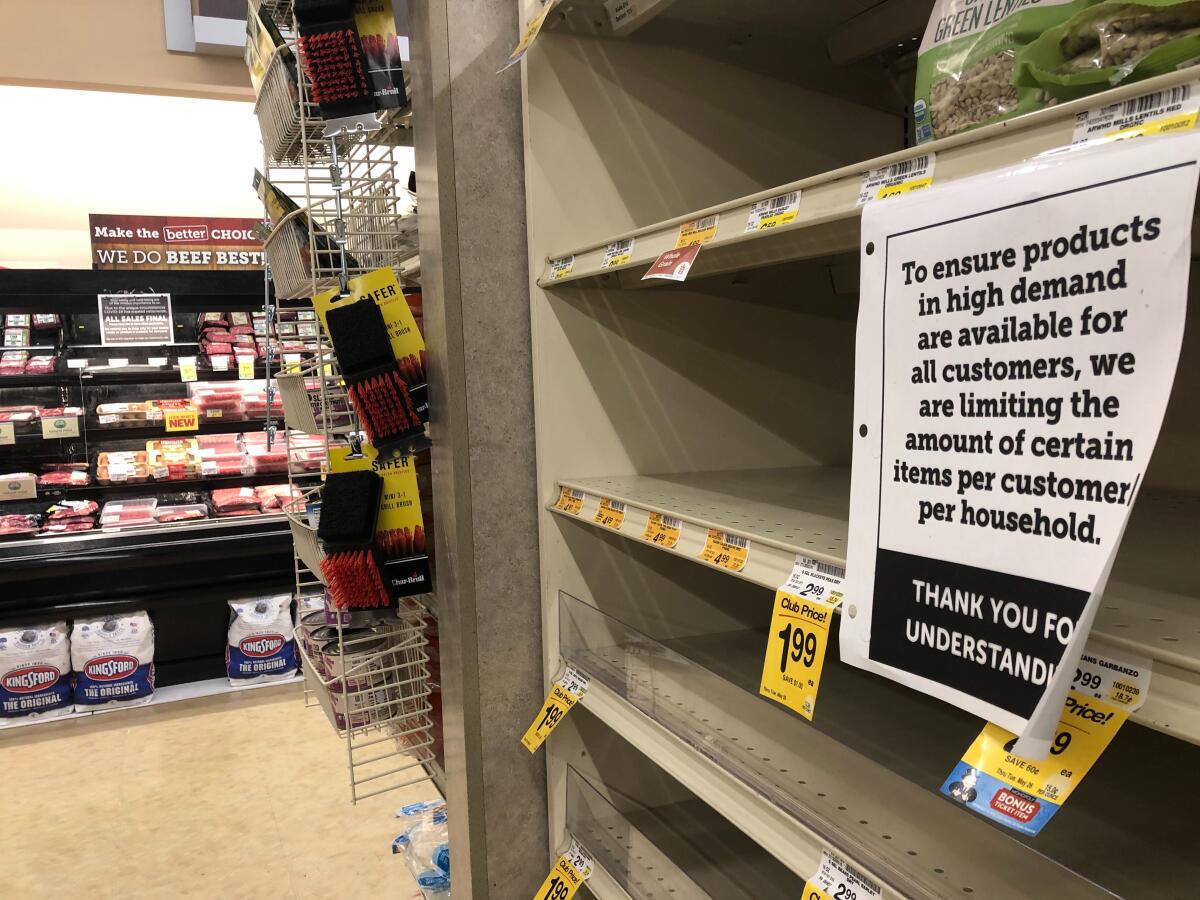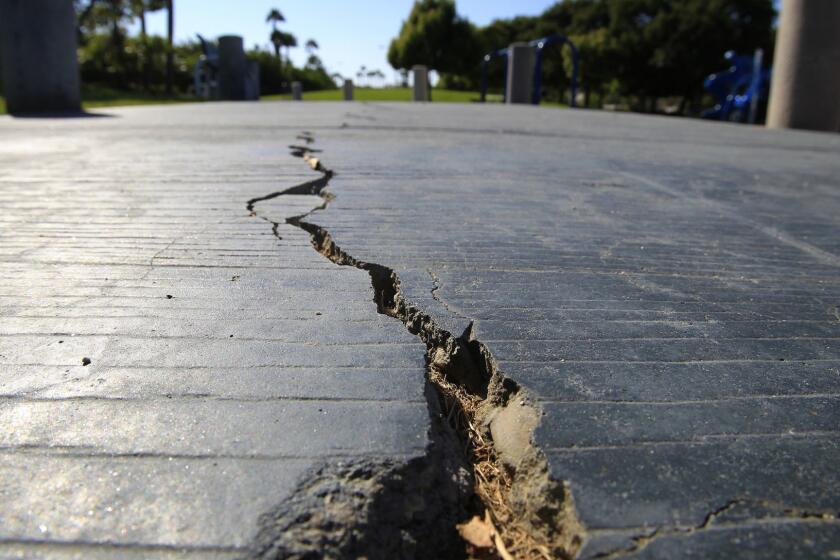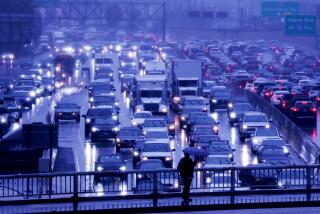Coronavirus caught us off guard. Here’s what disaster preppers say we needed to do all along

For three months, Jonathan and Kylene Jones didn’t step foot inside a grocery store. They relied on their Utah home’s built-in storage room supply: flour, rice, beans, a freezer full of food.
That was last summer.
The couple, founders of the “The Provident Prepper” website and YouTube channel, wanted to do a 90-day trial of surviving solely on their food storage and garden. Bartering and trading was allowed — their kids hauled hay for a nearby farmer one day in return for a Subway sandwich — but they couldn’t go to the grocery store. Those were the rules.
So when the coronavirus erupted in March, emptying grocery stores and turning others into hoarders overnight, Kylene and Jonathan Jones relaxed.
“When this pandemic struck, we’d already been through it,” said Kylene Jones, 55. “There was this great sense of peace that taught us that we’re just fine, we can do this.”
The Joneses acknowledge that very few people have the patience or time to do an experiment like theirs.
But a variety of people who prioritize preparedness say that most people can and should have supplies and plans to get them through several days. It’s doable without entertaining conspiracy theories or spending a fortune on special tools and supplies.
Here’s how to start.
Think it through
Yes, it might feel weird or unnerving to imagine worst-case scenarios. But thinking through possible disasters — especially now that we can envision one — is key to preparation and peace of mind, said Ontario’s fire administrative director Jordan Villwock.
“While it’s not fun to think about, it’s always better when an incident happens that you’re prepared,” Villwock said. “Hope is not a good contingency plan.”
Florida gets hurricanes. In the Midwest, tornadoes. California is blessed with earthquakes, wildfires and mudslides. Get to know your area’s specific vulnerabilities. Do you live on a fault line? Is your beachfront property susceptible to a tsunami? Look up your local jurisdiction’s hazard mitigation plan, which should detail threats unique to your area, Villwock recommends.
While you’re at it, look up evacuation routes for your neighborhood — include routes with the blue “evacuation” signs as well as little-known streets that might come in handy if the larger thoroughfares get blocked. Find routes that don’t use bridges or roads crossed by bridges. Know how to get out, in case of an emergency.

Plan for communication
Sit down with your family, roommates or neighbors and discuss. Decide on a meeting place in your neighborhood and one farther away, if it’s not safe to stay close to home. Agree on an out-of-state contact who can serve as an intermediary to help relay information. Memorize and write down that person’s contact information.
“Some people hesitate to feed their children information that’s scary, but I think it can be done in a non-threatening way,” said Jonathan Jones, 60. “It truly empowers them to look at a situation and say, ‘OK, here’s what we’ve already done and we can think this through.’”
Also write down your medical insurance, doctors’ contact information and any other health conditions (including allergies).
Many jurisdictions now have the capability to send messages through Amber alerts — remember your cellphone blaring the various curfew alerts? Individual cities and counties often have their own emergency alert systems. Sign up for them on your city’s website. You should also follow your local government, police and fire departments’ social media, which are often the first to sound the alarm about an emergency near you.
Get ready to go
Practiced preppers often have a couple different stores of supplies. Call it whatever you want — a go-bag, bugout bag, 72-hour supplies, or basic preparedness kit — it should be ready to go at a moment’s notice. Think of the 2018 Camp Fire, a deadly wildfire that tore through the Northern California town of Paradise in minutes.
Ready.gov, the federal preparedness website, advises that you fill your bag with the basic supplies we’re now all accustomed to — hand sanitizer, face masks and gloves — and some we’re not — an AM/FM crank radio, a flashlight, cellphone charger, extra batteries, a whistle, a utility tool, a blanket, a personal hygiene kit, bottles of water and at least three days of non-perishable food.
Villwock recommends also keeping cash in small bills in your bag, along with paper maps of your city.
“Think what life would be like if you’re finding places and you don’t have Google Maps anymore,” he said. “How would you get around?”
Don’t forget a first aid kit, which should contain supplies to treat an immediate injury and help you last a few hours if you can’t get medical help quickly. Villwock recommends bandages, ointment, antiseptic towelettes, an ice pack, tweezers and tape.
Once you have the basics down, customize. If you have children, add enough supplies for them too. If you live in a cold climate, pack a sweater, hat or boots. Perhaps you need medication for anxiety.
“Address stuff based on what’s going to kill you or cause you the largest problems the quickest,” said Dan Baird, founder and head instructor of the California Survival School. “Take care of your first aid needs and basic health and safety needs first.”
Keep your bag in a readily accessible place, like your car, a coat closet or garage. “You don’t want it buried deep in the closet in the middle of the house,” Baird said. If you keep the bag in your car, maybe add glow sticks so people can see you if you’re stranded one night on the side of the road.
Some experienced survivalists include other tools, ranging from eating utensils to things like the “doomsday axe.” But Villwock cautioned against getting caught up in all the advanced supplies.
“Having all those tools and blankets ... is going to make it more comfortable during the disaster,” Villwock said. “When you have reusable plates and can openers and duct tape and Q-tips, yeah that’s going to all come in handy, if necessary. But 72 hours, I could go without a Q-tip most likely, you know.”
Prepare the home
By now, we’re probably all accustomed to having a couple extras boxes of pasta or cans of beans in our pantry. But what do we really need in a home supply?
Preppers recommend plenty of non-perishable food and at least one gallon of water per person, per day. You’ll also need a backup of your medications and basic home tools. Frozen food is good too, but it may spoil quickly during a power outage.
How long should supplies last? Three weeks, three months or a year, depending on which prepper you ask. You’ll have to decide what length of time makes sense to you.
Once you do, they advise that you buy a little extra of your regular grocery list every week until you’re stocked up. Don’t waste money on items you never use, Baird said. Rotate through the items, keeping your supply’s shelf life fresh.
“Have your spaghetti, have your macaroni and cheese, have your oatmeal,” Baird said. “Have whatever it is you already like to eat.”
The Joneses agreed. During their 90-day survival trial, they learned they had packed too much tuna for their liking, but not enough cat food. They fed the tuna to the cats and adjusted their shopping list going forward. Also, Kylene Jones realized, they needed more chocolate.
Where to keep it all? Don’t be afraid to do a spring cleaning to maximize your pantry or closet space. Then get creative. In addition to a storage room on their 1.5 acres, the Joneses use empty space under their bed.
“We recognize that a lot of people can’t have that, or it’s not practicable, but whatever space you have, you can make it usable,” Jonathan Jones said.
Don’t get overwhelmed
If you’re stressed imagining the next disaster and the prospect of preparing for it seems too much, stop and take a breath. Think of prepping as the opposite of hoarding — get ready while you’re in a calm state of mind so you don’t have to panic later.
Preparing is also a form of community care, the Joneses said. Planning ahead means no last-minute runs to the store to stock up, taking away from other people in need.
“A lot of the reason people don’t prepare is because it seems overwhelming until you break it down,” Jonathan Jones said. “When you break it down into small, manageable pieces, then it’s doable, then you can make some real progress. And then what comes with that is a lot of peace of mind.”
So think ahead. Keep it simple. And don’t hoard toilet paper.
More to Read
Sign up for Essential California
The most important California stories and recommendations in your inbox every morning.
You may occasionally receive promotional content from the Los Angeles Times.

![People load cases of bottled water as customers buy emergency supplies ahead of Hurricane Hilary at a Costco warehouse in Hawthorne, California on August 19, 2023. Hilary continued on a steady path toward Mexico's Baja California peninsula on August 19 as a powerful hurricane that officials warned could bring "potentially catastrophic" flooding there and to parts of the US Southwest. The storm weakened from a powerful Category 4 to Category 3, but still deemed capable of "devastating damage," the US National Hurricane Center (NHC) said. (Photo by Patrick T. FALLON / AFP) / "The erroneous byline appearing in the metadata of this photo has been modified in AFP systems in the following manner: [Patrick T. FALLON] instead of [David SWANSON]. Please immediately remove the erroneous mention from all your online services and delete it from your servers. If you have been authorized by AFP to distribute it to third parties, please ensure that the same actions are carried out by them. Failure to promptly comply with these instructions will entail liability on your part for any continued or post notification usage. Therefore we thank you very much for all your attention and prompt action. We are sorry for the inconvenience this notification may cause and remain at your disposal for any further information you may require." (Photo by PATRICK T. FALLON/AFP via Getty Images)](https://ca-times.brightspotcdn.com/dims4/default/57c01da/2147483647/strip/true/crop/3874x2591+6+0/resize/320x214!/quality/75/?url=https%3A%2F%2Fcalifornia-times-brightspot.s3.amazonaws.com%2F79%2F43%2F7da635d447948553fce72eca34fd%2Fhttps-delivery-gettyimages.com%2Fdownloads%2F1610619030)










